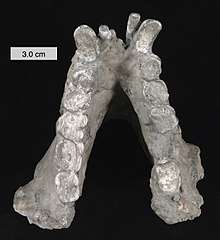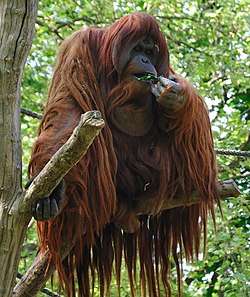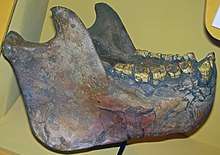Gigantopithecus
Gigantopithecus is an extinct genus of ape from the Early to Middle Pleistocene of southern China, represented by one species, G. blacki. The remains of Gigantopithecus, two third molar teeth, were first identified in a drugstore by anthropologist Ralph von Koenigswald in 1935, who subsequently described the ape. In 1956, the first mandible and over 1,000 teeth were found in Liucheng, and numerous more remains have since been found in at least 16 sites. Only teeth and 4 mandibles are known currently, and other skeletal elements were likely consumed by porcupines before they could fossilise. Gigantopithecus was once argued to be a hominin, a member of the human line, but it is now thought to be closely allied with orangutans, classified in the subfamily Ponginae.
| Gigantopithecus | |
|---|---|
 | |
| Cast of Gigantopithecus mandible | |
| Scientific classification | |
| Kingdom: | Animalia |
| Phylum: | Chordata |
| Class: | Mammalia |
| Order: | Primates |
| Suborder: | Haplorhini |
| Infraorder: | Simiiformes |
| Family: | Hominidae |
| Tribe: | †Sivapithecini |
| Genus: | †Gigantopithecus |
| Species: | †G. blacki |
| Binomial name | |
| †Gigantopithecus blacki von Koenigswald, 1935[1] | |
Gigantopithecus has traditionally been restored as a massive, gorilla-like ape, potentially 200–300 kg (440–660 lb) when alive, but the paucity of remains make total size estimates highly speculative. The species may have been sexually dimorphic, with males much bigger than females. The incisors are reduced and the canines appear to have functioned like cheek teeth (premolars and molars). The premolars are high-crowned, and the fourth premolar is very molar-like. The molars are the largest of any known ape, and have a relatively flat surface. Gigantopithecus had the thickest enamel by absolute measure of any ape, up to 6 mm (a quarter of an inch) in some areas, though was only fairly thick when tooth size is taken into account.
Gigantopithecus appears to have been a generalist herbivore of C3 forest plants, with the jaw adapted to grinding, crushing, and cutting through tough, fibrous plants; and the thick enamel functioning to resist foods with abrasive particles such as stems, roots, and tubers with dirt. Some teeth bear traces of fig family fruits. It primarily lived in subtropical to tropical forest, and went extinct about 300,000 years ago likely due to climate change and the retreat of preferred habitat, and potentially archaic human activity by Homo erectus.
Taxonomy
Research history
Gigantopithecus blacki was named by anthropologist Ralph von Koenigswald in 1935 based on 2 third lower molar teeth. He noted it as being "der enorme Grösse besitzt" ("of enormous size"), measuring 20 mm × 22 mm (0.79 in × 0.87 in).[1] The species name blacki is in honour of Canadian palaeoanthropologist Davidson Black, who had studied human evolution in China and had died the previous year. Von Koenigswald had found the teeth in a drugstore in Hong Kong where they were being sold as "dragon bones" to be used in traditional Chinese medicine. By 1939, after purchasing more teeth, he determined they had originated somewhere in Guangdong or Guangxi. He could not formally describe the type specimen until 1952 due to his internment by Japanese forces during World War II.[2][3]
In 1955, a survey team led by Chinese palaeontologist Pei Wenzhong was tasked by the Chinese Institute of Vertebrate Paleontology and Paleoanthropology (IVPP) with finding the original Gigantopithecus locality. They collected 47 teeth among shipments of "dragon bones" in Guangdong and Guangxi. In 1956, the team discovered the first in situ remains, and third molar and premolar, in a cave (subsequently named "Gigantopithecus Cave") in Niusui Mountain, Guangxi. Also in 1956, Liucheng farmer Xiuhuai Qin discovered more teeth and the first mandible on his field. From 1957 to 1963, the IVPP survey team carried out excavations in this area and recovered 2 more mandibles and more than 1,000 teeth.[2][4][5][3]
Confirmed Gigantopithecus remains have since been found in 16 different sites across southern China. The northernmost sites are Longgupo and Longgudong, just south of the Yangtze River, and southernmost on Hainan Island in the South China Sea. An isolated canine from Thẩm Khuyên Cave, Vietnam, and a fourth premolar from Pha Bong, Thailand, could possibly be assigned to Gigantopithecus, though these could also represent the extinct orangutan Pongo weidenreichi.[2] Two mandibles from Semono in Central Java, Indonesia, described in 2016 could represent Gigantopithecus.[6] The oldest remains date to 2 million years ago from Baikong Cave, and the youngest 380,000–310,000 years ago from Hei Cave.[2] In 2014, a fourth confirmed mandible was discovered in Yanliang, Central China.[7] Indicated by extensive rodent gnawing marks, teeth primarily accumulated in caves likely due to porcupine activity. Porcupines gnaw on bones to obtain nutrients necessary for quill growth, and can haul large bones into their underground dens and consume them entirely, except the hard, enamel-capped crowns of teeth. This may explain why teeth are typically found in great quantity, and why remains other than teeth are so rare.[2]
Classification
In 1935, von Koenigswald considered Gigantopithecus to be closely allied with the Late Miocene Sivapithecus from India.[1] In 1939, South African palaeontologist Robert Broom hypothesised that it was closely allied with Australopithecus and the last common ancestor of humans and other apes.[8] In 1946, Jewish German anthropologist Franz Weidenreich described Gigantopithecus as a human ancestor as "Gigantanthropus", believing that the human lineage went through a gigantic phase. He stated that the teeth are more similar to those of Homo erectus (at the time believed to the be earliest member of the human line) and modern humans.[9] In 1952, von Koenigswald agreed that Gigantopithecus was a hominin, but believed it was an offshoot rather than a human ancestor.[10] Much debate followed whether Gigantopithecus was a hominin or not for the next 3 decades until several early African hominins were discovered, placing humanity's origins in Africa instead of Asia. In 1969, an 8.6 Ma mandible from the Sivalik Hills in northern India was classified as G. bilaspurensis because at that time it was believed to have been the ancestor of Gigantopithecus.[2][3] This bore resemblance to a molar discovered in 1915 in the Pakistani Pothohar Plateau then classified as Dryopithecus giganteus. Von Koenigswald reclassified D. giganteus in 1950 into its own genus, Indopithecus, but this was changed again in 1979 to G. giganteus by American anthropologists Frederick Szalay and Eric Delson[11] until Indopithecus was resurrected in 2003 by Australian anthropologist David W. Cameron.[12][2] G. bilaspurensis is now considered a synonym of Indopithecus giganteus.[13][2]

Gigantopithecus is now classified in the subfamily Ponginae, closely allied with Sivapithecus and Indopithecus. This would make its closest living relatives the orangutans. However, there are few similar traits (synapomorphies) linking Gigantopithecus and orangutans due to fragmentary remains, with the main morphological argument being its close affinities to Sivapithecus, which is better established as a pongine based on skull features. In 2017, Chinese palaeoanthropologist Yingqi Zhang and American anthropologist Terry Harrison suggested that Gigantopithecus is most closely allied to the Chinese Lufengpithecus, which went extinct 4 million years prior to Gigantopithecus.[2]
In 2019, peptide sequencing of dentine and enamel proteins of a Gigantopithecus molar from Chuifeng Cave indicates that Gigantopithecus was indeed closely allied with orangutans, and, assuming the current mutation rate in orangutans has remained constant, shared a common ancestor about 12–10 million years ago in the Middle to Late Miocene. Their last common ancestor would have been a part of the Miocene radiation of apes. The same study calculated a divergence time between Ponginae and African great apes about 26–17.7 million years ago.[14]
Cladogram according to Zhang and Harrison, 2017:[2]
| Hominoidea (apes) |
| ||||||||||||||||||||||||||||||||||||||||||||||||||||||||||||||||||
Description

Total size estimates are highly speculative because only tooth and jaw elements are known, and molar size and total body weight do not always correlate, such as in the case of post-canine megadontia hominins with a small-bodied primate exhibiting comparatively massive molars and thick enamel.[15] In 1946, Weidenreich hypothesised that Gigantopithecus was twice the size of male gorillas.[9] In 1957, Pei estimated a total height of about 3.7 m (12 ft). In 1970, American palaeontologists Elwyn Simons and Peter Ettel approximated a height of almost 2.7 m (9 ft) and a weight of up to 270 kg (600 lb), which is about 42% heavier than a male gorilla. In 1979, American anthropologist A. E. Johnson Jr. used the dimensions of gorillas to estimate a femur length of 54.4 cm (1.78 ft) and humerus length of 62.7 cm (2.06 ft) for Gigantopithecus, about 20–25% longer than those of gorillas.[16] In 2017, Chinese palaeoanthropologist Yingqi Zhang and American anthropologist Terry Harrison suggested a body mass of 200–300 kg (440–660 lb), though conceded this was likely an overestimate and it is impossible to obtain a reliable body mass estimate without more complete remains.[2]
Gigantopithecus had a dental formula of 2.1.2.32.1.2.3, with 2 incisors, 1 canine, 2 premolars, and 3 molars in each half of the jaw for both jaws.[2] The average maximum length of upper canines for presumed males and females are 21.1 mm (0.83 in) and 15.4 mm (0.61 in), respectively, and Mandible III (presumed male) is 40% larger than Mandible I (presumed female), which implies sexual dimorphism with males being larger than females. Such a high degree of dimorphism in canine size is only surpassed by gorillas among modern apes, and is surpassed by none for mandibular disparity.[2] The canines, due to a lack of honing facets (which keep them sharp) and their overall stoutness, have been suggested to have functioned like premolars and molars (cheek teeth). Like other apes with enlarged molars, the incisors of Gigantopithecus are reduced.[17][18] Wearing on the tongue-side of the incisors (the lingual face), which can extend as far down as the tooth root, suggests an underbite.[2] Overall mandibular anatomy and tooth wearing suggests a side-to-side movement of the jaw while chewing (lateral excursion).[19] The incisors and canines have extremely long tooth roots, at least double the length of the tooth crown (the visible part of the tooth). These teeth were closely packed together.[2]

The tooth enamel on the molars is in absolute measure the thickest of any known ape, averaging 2.5–2.9 mm (0.098–0.114 in) in 3 different molars, and over 6 mm (0.24 in) on the tongue-side (lingual) cusps of an upper molar.[19] This has attracted comparisons with the extinct Paranthropus hominins, which had extremely large molars and thick enamel for their size.[19][17] However, in relation to the tooth's size, enamel thickness for Gigantopithecus overlaps with that of several other living and extinct apes. Like orangutans and potentially all pongines (though unlike African apes) the Gigantopithecus molar had a large and flat (tabular) grinding surface, with an even enamel surface, short dentine horns (the areas of the dentine layer which project upwards into the top enamel layer), and a shallow fossa (the depression).[15] The molars are the most hypsodont (where the enamel extends beyond the gums) of any ape.[2] A Gigantopithecus permanent third molar, based on an approximate 600–800 days required for the enamel on the cusps to form (which is quite long), was estimated to have taken 4 years to form, which is within the range (albeit, far upper range) of what is exhibited in humans and chimpanzees. Like many other fossil apes, the rate of enamel formation near the enamel-dentine junction (dentine is the nerve-filled layer beneath the enamel) was estimated to begin at about 4 μm per day; this is seen in only baby teeth for modern apes.[17] The third molar is smaller than the second molar.[2] Protein sequencing of Gigantopithecus enamel identified alpha-2-HS-glycoprotein (AHSG), which, in modern apes, is important in bone and dentine mineralisation. Because it was found in enamel, and not dentine, AHSG may have been an additional component in Gigantopithecus which facilitated biomineralisation of enamel during prolonged amelogenesis (enamel growth).[14]
In the upper jaw, the third premolar averages 20.3 mm × 15.2 mm (0.8 in × 0.6 in) in surface area, the fourth premolar 15.2–16.4 mm (0.60–0.65 in), the first and/or second molars (which are difficult to distinguish) 19.8 mm × 17.5 mm (0.78 in × 0.69 in), and the third molar 20.3 mm × 17.3 mm (0.80 in × 0.68 in). In the lower jaw, the third premolar averages 15.1 mm × 20.3 mm (0.59 in × 0.80 in), the fourth premolar 13.7 mm × 20.3 mm (0.54 in × 0.80 in), the first/second molars 18.1 mm × 20.8 mm (0.71 in × 0.82 in), and the third molar 16.9 mm × 19.6 mm (0.67 in × 0.77 in). The molars are the biggest of any known ape.[2] Teeth appear to have increased in size over time.[20] The premolars are high-crowned, and the lower have 2 tooth roots whereas the upper have 3. The lower molars are low-crowned, long and narrow, and waist at the midline—which is more pronounced in the lower molars—with low-lying and bulbous cusps and rounded-off crests.[2]
The 400–320,000 year old Middle Pleistocene teeth from Hejiang Cave in southeast China show some differences from Early Pleistocene material from other sites, which could potentially indicate that the Hejiang Gigantopithecus were a specialised form adapting to a changing environment with different food resources. The Hejiang teeth display a less level (more crenulated) outer enamel surface due to the presence of secondary crests emanating from the paracone and protocone on the side of the molar closer to the midline (medially), as well as sharper major crests.[7][21][22]
Palaeobiology

Gigantopithecus is considered to have been a herbivore. Carbon-13 isotope analysis suggests consumption of C3 plants—such as fruits, leaves, and other forest plants—and Gigantopithecus was likely a generalist feeder.[23] The robust mandible of Gigantopithecus indicates it was capable of resisting high strains while chewing through tough or hard foods. However, the same mandibular anatomy is typically seen in modern apes which primarily eat soft leaves (folivores) or seeds (granivores). Gigantopithecus teeth have a markedly lower rate of pitting (caused by eating small, hard objects) than orangutans, more similar to the rate seen in chimpanzees, which could indicate a similarly generalist diet.[2]
Thick enamel would suggest a diet of abrasive items, such as food near on the ground (like bamboo shoots).[19] The molar-like premolars, large molars, and long rooted cheeked teeth could point to chewing, crushing, and grinding of bulky and fibrous materials.[24][25] Oxygen isotope analysis suggests Gigantopithecus consumed more low-lying plants such as stems, roots, and grasses than orangutans. Dental calculus indicates the consumption of tubers.[26] The Gigantopithecus teeth from Hejiang Cave dated to near the time of extinction have some anatomical differences to those of Early Pleistocene Gigantopithecus, which could suggest a shift in diet due to changes in the environment and food resources.[22]
Gigantopithecus molars have a cavity rate similar to that of chimpanzees, which could mean fruit was included in its diet.[2] Specimen PA1601-1 from Yanliang Cave shows evidence of tooth loss of the right second molar before the eruption of the neighboring third molar (which grew slantedly), which suggests this individual was able to survive for a long time despite impaired chewing abilities.[7] Gigantopithecus does not appear to have consumed the savanna grasses (C4 plants) which were also common in its environment.[23] Nonetheless, a few phytoliths adhering to molars were identified to have originated from grasses, though the majority of phytoliths resemble the hairs of fig family fruits, which includes figs, mulberry, breadfruit, durian, and banyan.[25]
In 1957, based on hoofed animal remains in a cave located in a seemingly inaccessible mountain, Pei had believed that Gigantopithecus was a cave-dwelling predator and carried these animals in.[27] This hypothesis is no longer considered viable because its dental anatomy is consistent with herbivory.[23] In 1975, American palaeoanthropologist Tim D. White drew similarities between the jaws and dentition of Gigantopithecus and those of the panda, and suggested they both occupied the same niche as bamboo specialists.[28] This garnered support from some subsequent researchers, but thicker enamel and hypsodonty in Gigantopithecus could suggest different functionality for these teeth.[19]
The high levels of sexual dimorphism could indicate relatively intense male–male competition, though considering the upper canines only projected slightly farther than the cheek teeth, canine display was probably not very important in agonistic behaviour.[2]
Palaeoecology

Gigantopithecus remains are generally found in subtropical evergreen broadleaf forest in South China, except in Hainan which features a tropical rainforest. Carbon and oxygen isotope analysis of Early Pleistocene enamel suggests Gigantopithecus inhabited dense, humid, closed-canopy forest. Queque Cave featured a mixed deciduous and evergreen forest dominated by birch, oak, and chinkapin, as well as several low-lying herbs and ferns.[2]
The "Gigantopithecus fauna", one of the most important mammalian faunal groups of the Early Pleistocene of southern China, includes tropical or subtropical forest species. This group has been subdivided into 3 stages spanning 2.6–1.8 million years ago, 1.8–1.2 million years ago, and 1.2–0.8 million years ago. The early stage is characterised by more ancient Neogene animals such as the elephant Sinomastodon, the chalicothere Hesperotherium, the pig Dicoryphochoerus, the mouse-deer Dorcabune, and the deer Cervavitus. The middle stage is indicated by the appearance of the panda Ailuropoda wulingshanensis, the dhole Cuon antiquus, and the tapir Tapirus sinensis. The late stage features more typical Middle Pleistocene animals such as the panda Ailuropoda baconi and the elephant Stegodon.[29] Other classic animals typically include orangutans, macaques, rhinos, the extinct pigs Sus xiaozhu and S. peii, muntjac, Cervus (a deer), gaur (a cow), the goat-antelope Megalovis, and more rarely the large sabre-toothed Megantereon.[30] Longgudong Cave may have represented a transitional zone between the Palaearctic and Oriental realms, featuring, alongside the typical Gigantopithecus fauna, animals such as hedgehogs, hyenas, horses, the cow Leptobos, and pikas.[29]
Gigantopithecus appears to have gone extinct about 300,000 years ago, possibly due to the southward retreat of forest and prime habitat throughout the Middle Pleistocene caused by increasing seasonality and monsoon strength, and a cooling trend.[20] It has been speculated that immigrating H. erectus also contributed to extinction.[31] Human activity in southern China is known as early as 800,000 years ago, but increased human activity occurs 300,000 years ago, after the extinction of Gigantopithecus, so it is unclear if pressures such as competition over resources or overhunting were factors.[20]
See also
| Wikimedia Commons has media related to Gigantopithecus. |
| Wikispecies has information related to Gigantopithecus |
References
- von Koenigswald, G. H. R. (1935). "Eine fossile Säugetierfauna mit Simia aus Südchina" (PDF). Proceedings of the Koninklijke Akademie van Wetenschappen te Amsterdam. 38 (8): 874–875.
- Zhang, Y.; Harrison, T. (2017). "Gigantopithecus blacki: a giant ape from the Pleistocene of Asia revisited". American Journal of Physical Anthropology. 162 (S63): 153–177. doi:10.1002/ajpa.23150.
- Hartwig, W. C. (2002). The Primate Fossil Record. Cambridge University Press. pp. 371–372. ISBN 978-0-521-66315-1.
- Poirier, F.E.; McKee, J.K. (1999). Understanding Human Evolution (fourth ed.). Upper Saddle River, New Jersey: Prentice Hall. p. 119. ISBN 0130961523.
- Coichon, R. (1991). "The ape that was – Asian fossils reveal humanity's giant cousin". Natural History. 100: 54–62. ISSN 0028-0712. Archived from the original on May 25, 2015.CS1 maint: unfit url (link)
- Sofwan, N.; et al. (2016). "Primata Besar di Jawa: Spesimen Baru Gigantopithecus dari Semedo" [Giant Primate of Java: A new Gigantopithecus specimen from Semedo] (PDF). Berkala Arkeologi. 36 (2): 141–160.
- Zhang, Y.; Jin, C.; et al. (2015). "A fourth mandible and associated dental remains of Gigantopithecus blacki from the Early Pleistocene Yanliang Cave, Fusui, Guangxi, South China". Historical Biology. 28 (1–2): 95–104. doi:10.1080/08912963.2015.1024115.
- Broom, R. (1939). "The dentition of the Transvaal Pleistocene anthropoids, Plesianthropus and Paranthropus" (PDF). Annals of the Transvaal Museum. 19 (3): 303–314.
- Weidenreich, F. (1946). Apes, Giants, and Man. University of Chicago Press. pp. 58–66.
- von Koenigswald, G. H. R. (1952). "Gigantopithecus blacki von Koenigswald, a giant fossil hominoid from the Pleistocene of southern China". Anthropological Papers of the American Museum of Natural History. 43: 292–325.
- Szalay, F.; Delson, E. (1979). Evolutionary History of the Primates. Academic Press. pp. 493–494. ISBN 978-1-4832-8925-0.
- Cameron, D. (2003). "A functional and phylogenetic interpretation of the late Miocene Siwalik hominid Indopithecus and the Chinese Pleistocene hominid Gigantopithecus". Himalayan Geology. 24: 19–28.
- Cameron, D. (2001). "The taxonomic status of the Siwalik late Miocene hominid Indopithecus (= Gigantopithecus)". Himalayan Geology. 22: 29–34.
- Welker, F.; Ramos-Madrigal, J.; Kuhlwilm, M.; et al. (2019). "Enamel proteome shows that Gigantopithecus was an early diverging pongine". Nature. doi:10.1038/s41586-019-1728-8. PMC 6908745.
- Olejniczak, A. J.; et al. (2008). "Molar enamel thickness and dentine horn height in Gigantopithecus blacki" (PDF). American Journal of Physical Anthropology. 135 (1): 85–91. doi:10.1002/ajpa.20711. PMID 17941103. Archived from the original (PDF) on 2016-03-03.
- Johnson Jr., A. E. (1979). "Skeletal Estimates of Gigantopithecus Based on a Gorilla Analogy". Journal of Human Evolution. 8: 585–587.
- Dean, M. C.; Schrenk, F. (2003). "Enamel thickness and development in a third permanent molar of Gigantopithecus blacki". Journal of Human Evolution. 45 (5): 381–388. doi:10.1016/j.jhevol.2003.08.009.
- Ciochon, R.; et al. (1996). "Dated Co-Occurrence of Homo erectus and Gigantopithecus from Tham Khuyen Cave, Vietnam" (PDF). Proceedings of the National Academy of Sciences of the United States of America. 93 (7): 3016–3020. doi:10.1073/pnas.93.7.3016. PMC 39753. PMID 8610161.
- Kono, R. T.; Zhang, Y.; Jin, C.; Takai, M.; Suwa, G. (2014). "A 3-dimensional assessment of molar enamel thickness and distribution pattern in Gigantopithecus blacki". Quaternary International. 354: 46–51. doi:10.1016/j.quaint.2014.02.012.
- Shao, q.; Wang, Y.; et al. (2017). "U-series and ESR/U-series dating of the Stegodon–Ailuropoda fauna at Black Cave, Guangxi, southern China with implications for the timing of the extinction of Gigantopithecus blacki". Quaternary International. 434: 65–74. doi:10.1016/j.quaint.2015.12.016.
- Zhang, Y.; Kono, R. T.; Jin, C.; Wang, W.; Harrison, T. (2014). "Possible change in dental morphology in Gigantopithecus blacki just prior to its extinction: evidence from the upper premolar enamel–dentine junction". Journal of Human Evolution. 75: 166–171. doi:10.1016/j.jhevol.2014.06.010.
- Zhang, Y.; Kono, R. T.; Jin, C.; Wang, W.; et al. (2014). "New 400–320 ka Gigantopithecus blacki remains from Hejiang Cave, Chongzuo City, Guangxi, South China". Quaternary International. 354: 35–45. doi:10.1016/j.quaint.2013.12.008.
- Bocherens, H.; Schrenk, F.; Chaimanee, Y.; Kullmer, O.; Mörike, D.; Pushkina, D.; Jaeger, J.-J. (2017). "Flexibility of diet and habitat in Pleistocene South Asian mammals: Implications for the fate of the giant fossil ape Gigantopithecus". Quaternary International. 434: 148–155. doi:10.1016/j.quaint.2015.11.059.
- Kupczik, K.; Dean, M. C. (2008). "Comparative observations on the tooth root morphology of Gigantopithecus blacki". Journal of Human Evolution. 54 (2): 196–204. doi:10.1016/j.jhevol.2007.09.013. PMID 18045651.
- Ciochon, R. (1991). "The ape that was – Asian fossils reveal humanity's giant cousin". Natural History. 100: 54–62. ISSN 0028-0712. Archived from the original on May 25, 2015.CS1 maint: unfit url (link)
- Qu, Y.; Jin, C.; Zhang, Y.; et al. (2014). "Preservation assessments and carbon and oxygen isotopes analysis of tooth enamel of Gigantopithecus blacki and contemporary animals from Sanhe Cave, Chongzuo, South China during the Early Pleistocene". Quaternary International. 354: 52–58. doi:10.1016/j.quaint.2013.10.053.
- Pei, W. (1957). "Giant ape's jaw bone discovered in China". American Anthropologist: 834–838. doi:10.1525/aa.1957.59.5.02a00080.
- White, T. D. (1975). "Geomorphology to paleoecology: Gigantopithecus reappraised". Journal of Human Evolution. 4 (3): 219–233. doi:10.1016/0047-2484(75)90009-3.
- Jin, C.; Wang, Y.; et al. (2014). "Chronological sequence of the early Pleistocene Gigantopithecus faunas from cave sites in the Chongzuo, Zuojiang River area,South China". Quaternary International. 354: 4–14. doi:10.1016/j.quaint.2013.12.051.
- Zhu, M.; Schubert, B. W.; Liu, J.; Wallace, S. C. (2014). "A new record of the saber-toothed cat Megantereon (Felidae, Machairodontinae) from an Early Pleistocene Gigantopithecus fauna, Yanliang Cave, Fusui, Guangxi, South China". Quaternary International. 354: 100–109. doi:10.1016/j.quaint.2014.06.052.
- "New fossil evidence and diet analysis of Gigantopithecus blacki and its distribution and extinction in South China". Quaternary International. 286: 69–74. 12 February 2013. doi:10.1016/j.quaint.2011.12.016. ISSN 1040-6182.
